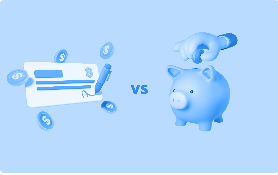Ask Raisin: What is a certified check?
Summary
A certified check is a personal check verified by your bank to ensure sufficient funds for major purchases. This guide explains certified checks, how they differ from cashier's checks and money orders, and how to obtain one.

Sometimes a transaction requires a little extra peace of mind. A cashier’s check is a personal check that is formally verified by a bank or credit union. When you pay for a major purchase with a certified check, you’ll have the confidence that the funds you need are available. While these checks aren’t fraud-proof, they can make certain transactions feel more secure.
If you have a major purchase coming up, such as a car or house, you might consider paying with a certified check. In this guide, we’ll explain how to obtain a certified check and how they differ from other payment types, like cashier’s checks.
Continue reading to learn all you need to know about choosing the right payment type for your next large transaction.
What is a certified bank check?
A certified check is a way to guarantee you have sufficient funds available before completing a transaction.
You can only request a certified check from a bank branch. Once the request is made, the bank will verify that you have the funds in your account. They will then place a hold on those funds. That way, you can ensure you cannot spend or withdraw the money before the certified check is cashed or deposited.
When your payee cashes or deposits the check, those funds will be released to them.
In most other ways, a certified check works like a standard personal check. The main difference is that the bank will stamp your check as proof of certification. You are still responsible for signing the check. Likewise, all funds will be drawn from your account.
Paying with a certified check ensures you cannot overdraw your account and that the check will not bounce. It also provides peace of mind for payees, who know you have the means and ability to pay. In essence, they can be confident that the check is a source of guaranteed funds. Because the funds are pre-vetted, they also often clear faster than personal checks.
Consumers may choose to use a certified check for a larger purchase, such as the downpayment on a house. It’s also wise to use a certified check when completing a transaction with someone you do not know well. It’s a simple way to prove that you are trustworthy.
Where to get a certified check
You can only request a certified check in person at a bank branch. You cannot request a certified check online or over the phone. It may be easier to go to a bank branch where you already have an account. Be sure to bring a government-issued photo ID and your checkbook with you.
It’s wise to double-check that your bank offers certified checks first. Some banks may only offer cashier’s checks, a secure alternative to a certified check. We’ll discuss the differences later in this article.
How to get a certified check
To request a certified check, the first step is generally to visit your bank.
If your bank offers certified checks, you’ll request one directly from a teller or bank representative. Let them know who the recipient is and what amount the check is for. You will need to fill out the check in front of the bank representative to get it certified. They will then certify and stamp the check.
Often, you will pay a small fee and be given a receipt. Then, wait for the check to clear your account. At that point, you are free to give the check to your recipient.
Is there a charge for a certified check?
You may or may not have to pay for a certified check.
There is often a small charge for a certified check, typically between $5 and $20, though this rate varies. However, some banks will waive this fee for certain account holders. For example, long-time account holders or those with premium accounts or high balances may not have to pay.
Certified check vs. cashier’s check vs. money order
A certified check, a cashier’s check, and a money order are all ways to ensure a more secure transaction. They guarantee funds and may involve a small fee. However, all three forms of payment have significant differences.
Cashier’s checks
When you request a cashier’s check, funds from your personal checking account will be transferred to the issuing bank. When the recipient cashes the check, the funds will be drawn from the bank’s account instead of yours. The banker, not you, will sign and certify the check.
Cashier’s checks may also be somewhat more flexible. You can typically request them online or over the phone. In contrast, certified checks can only be requested in person at a physical bank branch.
Money orders
Another alternative to a certified check is a money order. You can purchase money orders at many retail stores and post offices.
Most money orders cannot exceed $1000. In contrast, certified checks are often used for higher ticket purchases. Each bank sets its own limits for the maximum amount of a certified check, often as high as a million dollars.
Money order funds are not backed by a bank. They typically take longer to fully clear than either certified checks or cashier’s checks. Many consumers find them more convenient than certified checks, as you can get them at retail stores.
Educate yourself with Raisin
Are you interested in learning more about banking and finances? Head to our banking guides dedicated to financial wellness and learning.
The above article is intended to provide generalized financial information designed to educate a broad segment of the public; it does not give personalized tax, investment, legal, or other business and professional advice. Before taking any action, you should always seek the assistance of a professional who knows your particular situation for advice on taxes, your investments, the law, or any other business and professional matters that affect you and/or your business.


